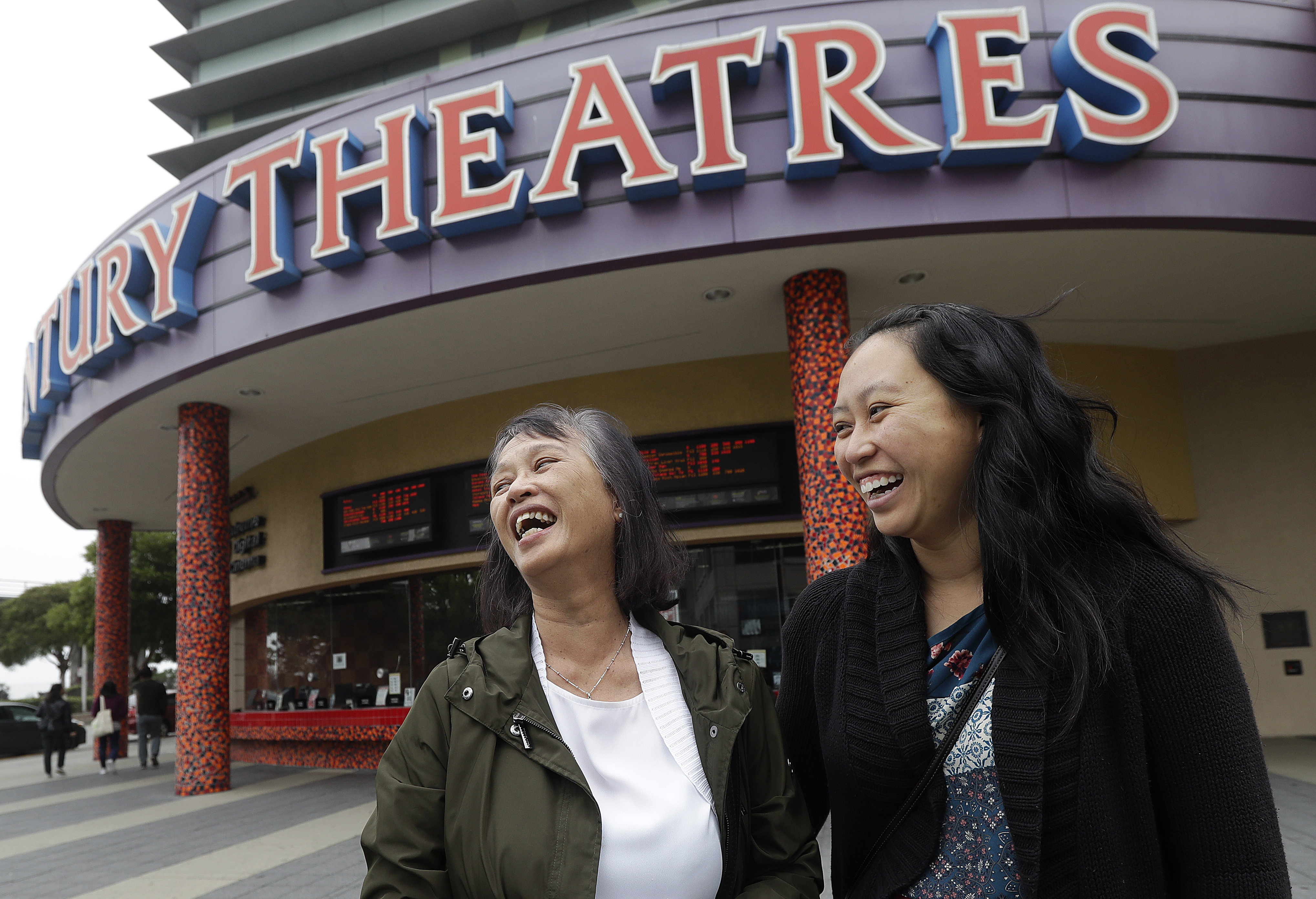
Alice Sue, left, and her daughter Audrey Sue-Matsumoto laugh while interviewed Thursday after watching the movie Crazy Rich Asians in Daly City, California. It was Sue’s second time watching the movie. When “Crazy Rich Asians” surpassed expectations and grabbed the top spot in its opening weekend, the film also pulled off another surprising feat. It put Asians of a certain age in theater seats. (AP )
When “Crazy Rich Asians” surpassed expectations and grabbed the top spot at the box office in its opening weekend, the film also pulled off another surprising feat: It put Asians of a certain age in theater seats.
Younger Asian-Americans have been flocking with their parents to see the first Hollywood movie in 25 years with an all-Asian cast.
For many older, first-generation Asian immigrants, going to the movies doesn’t rank high among hobbies and interests. The crowds, the language barrier and ticket prices are often turnoffs.
But the appeal of “Crazy Rich Asians,” the story of a culture clash that erupts when an Asian-American woman from New York meets her boyfriend’s family in Singapore, has bridged a real-life generation gap.
Earning more than $40 million since its Aug. 15 release, the film already has a sequel in development.
An adaptation of Kevin Kwan’s bestselling novel, the rom-com is poised to hit the $100 million mark due to its popularity and a lack of strong competition in the next month, comScore senior media analyst Paul Dergarabedian said.
“The over-performance of ‘Crazy Rich Asians’ shows the power of a great movie with universal themes to draw all audiences and also to break down preconceived notions of what can constitute a box office hit,” Dergarabedian said.
Broken down by ethnicity, Asians made up nearly 40 percent of the film’s audience during its opening weekend, Warner Bros said. By comparison, Asian/Pacific Islanders comprised just 10 percent of the audience in the opening days of last year’s “Spider-Man: Homecoming,” according to an analysis done by comScore/Screen Engine’s PostTrak.
The jump can be partly credited to enthusiastic Asian-Americans who wanted their parents to be part of what the film’s star, Constance Wu, has called a “movement.”
Lie Shia Ong-Sintzel, 36, of Seattle talked her parents into coming along the second time she saw the movie. It was the first time in five years the couple — Chinese immigrants from Indonesia — had been to the cinema.
“They don’t really go to movies in the theater. I usually have to drag them,” Ong-Sintzel said. “I felt like this was a big occasion — a movie with an all-Asian cast.”
Looking at her parents, she cried because everything from the acting to the food seemed to resonate more. She wasn’t the only one.
“I looked over again, my dad was wiping tears from his eyes,” Ong-Sintzel said.
In Temple City, California, Catherine Fanchiang, 27, who is Taiwanese-American, went to see the film a third time to keep her parents company.
Fanchiang’s mother, Kao Han Fan, also wanted to see the movie because she recognized Michelle Yeoh, who plays a wary matriarch. But it was Wu’s character who touched the 64-year-old the most. Fan said she liked how the story depicted an “ABC,” (American-born Chinese) who showed Asian cultural values such as putting family first.
“When you grow up in an Asian family … it will be in your mind when you do something, you will always think about other people,” Fan said. “You are not really, really selfish, thinking about yourself.”
Fanchiang enjoyed watching her parents see an American film with Asians that wasn’t a period piece.
“It was just a regular movie that just happens to have Asian people in it. It’s not like we’re ninjas or we’re good at fighting. It’s Asians existing in the modern world,” Fanchiang said.
The stars and director Jon M. Chu have said they wanted the film to showcase Asians who weren’t stereotypes or little-used side-players.
In the case of Alice Sue and her daughter, Audrey Sue-Matsumoto, the 67-year-old mother saw the movie first. She went a second time Thursday in the San Francisco Bay Area suburb of Daly City with her daughter. Sue, who is Chinese, doesn’t go to the movies much but knew she had to see this one.
“It’s talking about Asian culture. It’s real Asians mixed with American-born Asians,” Sue said. “And I want to support the Asian movies.”
Sue-Matsumoto, 35, said there probably wasn’t a more fitting film for the two to see together.
“It was good to watch it with my mom because I feel like it was very relatable in our situation,” Sue-Matsumoto said. “She’s an immigrant, and I’m American-born. That movie has that generational distinction.”
For Mark Gadia, 36, of Chula Vista, California, the movie led to him learning more about his parents’ courtship in the Philippines. His parents related to Wu and Henry Golding’s star-crossed couple because of how his mother was treated by her future in-laws.
“She apparently wasn’t good enough for my dad. It took this movie to make this revelation of how they met,” Gadia said.
He did not expect to come away having enjoyed seeing the film alongside his parents as much as he did.
“As sappy as this sounds, it’s something I’ll always remember,” Gadia said. “It’s kind of sad it took 25 years, but I’m glad I had the opportunity to have this experience as an adult.”

